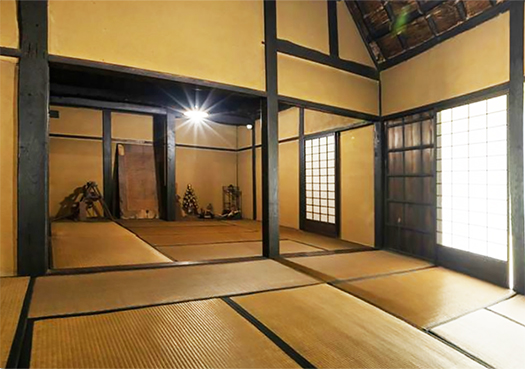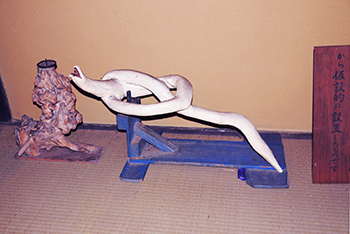

江戸期から残る古民家では格式的空間では写真のようなデザインをほぼ踏襲する。
床壁天井という3次元を構成する素材群では
構造の柱梁は無意匠であらわしであり、壁はその地域に近い場所からの
土を加工した塗り壁が覆っている。
天井は張られる場合は木質が張られる。
そしてタタミで床が敷き詰められている、という空間デザイン。
たぶんこういった空間構成に対して
江戸期の間での経済的発展過程でわたしたちの感性は慣れてきたはず。
庶民レベルではたぶん高々400-500年間程度の時間蓄積。
それ以前には板敷きの床だったかどうか、
土座から床上げした程度が普遍的なスタイルだったと思われる。
そういう庶民の暮らしようが、より高級な生活文化を謳歌していた
上流貴族たちの空間レベルに向かって上昇志向していたのでしょう。
たぶん、江戸期の庶民たちは少し余裕ができたら実現したいと
こういう空間性にある種の「憧れ」を感じ続けていたに違いない。
こういった空間での過ごし方の生活文化規範として
「茶」というスタイルが普遍性を持って浸透していったのだろうか。
今に至るも、日本人はこういう空間ではタタミの床に座って
ふるまわれる茶を喫するという応接接遇を一般化してきた。
正座という日本人オリジナルと思える座り方も
こういった空間で発展したライフスタイルだっただろうと思う。
現代人からすると、こういう空間性の文化正統性根拠ってなんだろうかと
はるかなDNA探索をするけれど、よく実感が湧かない。
古民家ではこういう室内構成の場所は「応接空間」であって、
ふだんの暮らしは板敷き+座布団の居室が主だった。
そう考えるとこうした空間は一種のホテルのようなもので、
たまに来る遠路の来客への対応空間でありその家の見栄の部分の表出かと。
心づくしと見栄の複合したような空間性だったのかも知れない。
画面奥の壁面は、まだ「床の間」にはなっていないけれど、
客人との会話の契機になるような「飾り物」が置かれている。

この白いヘビにはきっと宗教的まじない性があるのだろうけれど、
一種ユーモラスでもあって、接遇の展示品としての面白みも感じられる。
わたしなどは確実にその魅力にノックダウンされてしまった(笑)。
明治以降、そして顕著には戦後以降、
日本人は「洋風化」というものに帰依してきた。
日本は「ガイアツ」に弱いというか、それを利用した転換が巧みというか、
ライフスタイルがまったく変わったけれど、
結果として、このような空間性は現代住宅から姿を消しつつある。
だいたい住宅にホテル機能が不要なほどホテルが多くなった。
やはり不可逆的変化ということなのだと思うけれど、
どこかの時点でDNAレベル的「逆回転」が起こるかも知れない、まだわからない。
日本社会は外圧の後、必ず「国風化」も起こる伝統がある・・・。
English version⬇
[Sensitivity of pillars&Beams, plaster walls, tatami mats / Japanese good house ㉜-4]
In the old folk house that remains from the Edo period, the design as shown in the photograph is almost followed in the formal space.
In the material group that composes three dimensions called floor, wall, and ceiling
The pillars and beams of the structure are undesigned, and the walls are from a location close to the area.
It is covered with a plastered wall made of soil.
If the ceiling is stretched, it will be covered with wood.
And the space design that the floor is covered with tatami mats.
Maybe for this kind of spatial composition
Our sensibilities must have become accustomed to the process of economic development during the Edo period.
At the common people level, it probably accumulates time for at most 400-500 years.
Whether it was a wooden floor before that,
It seems that the degree of raising the floor from the ground seat was a universal style.
The way of life of such ordinary people enjoyed a higher-class life culture.
Perhaps they were going up towards the spatial level of the upper aristocrats.
Maybe the common people in the Edo period want to realize it if they can afford it a little.
I must have continued to feel a certain kind of “longing” for this kind of spatiality.
As a living culture norm of how to spend in such a space
Did the style of “tea” permeate with universality?
Even now, Japanese people sit on the floor of tatami mats in this kind of space.
We have generalized the reception service of enjoying the tea that is served.
There is also a sitting style that seems to be a Japanese original called Seiza
I think it was a lifestyle that developed in such a space.
From the perspective of modern people, what is the basis for such spatial legitimacy of culture?
I do a far DNA search, but I don’t really feel it.
In an old folk house, the place with such an indoor structure is a “reception space”,
Most of my daily life was a room with wooden floors and cushions.
With that in mind, these spaces are like a kind of hotel.
It’s a space for responding to the occasional long-distance visitors, and it’s an expression of the appearance of the house.
It may have been a spatiality that was a combination of mindset and appearance.
The wall at the back of the screen is not yet a “tokonoma”,
“Ornaments” are placed to trigger conversations with guests.
I’m sure this white snake has a religious spell, but
It’s also a kind of humor, and you can feel the fun as an exhibit of hospitality.
I was surely knocked down by its charm (laughs).
After the Meiji era, and notably after the war
The Japanese have been “devoted” to what is called “westernization.”
Japan is vulnerable to “gaiatsu”, or the conversion using it is skillful.
The lifestyle has changed completely,
As a proof of this, such spatiality is disappearing from modern homes.
The number of hotels has increased so much that the hotel function is not necessary for most houses.
I think it’s an irreversible change, but
At some point a DNA-level “reverse rotation” may occur, not yet known.
Japanese society has a tradition of “national weathering” after external pressure.
Posted on 5月 28th, 2021 by 三木 奎吾
Filed under: 住宅マーケティング, 日本社会・文化研究







コメントを投稿
「※誹謗中傷や、悪意のある書き込み、営利目的などのコメントを防ぐために、投稿された全てのコメントは一時的に保留されますのでご了承ください。」
You must be logged in to post a comment.